The inevitable decline of official institutions that have to do with the arts. Based on the belief of the immutable laws of art. Any institution that sets itself up as the guardian of such laws is, by that very fact, a thing of the past. There is still a tyranny of taste, but the tyrants concerned are dealers and critics and collectors. To be a member of the Royal Academy was once a great advantage, both financially, socially and professionally. British painters only got around to forming their own Academy in 1768, but not surprising since alongside the genius of a Holbein, Van Dyck, or a Rubens, the British artists were thoroughly outclassed.
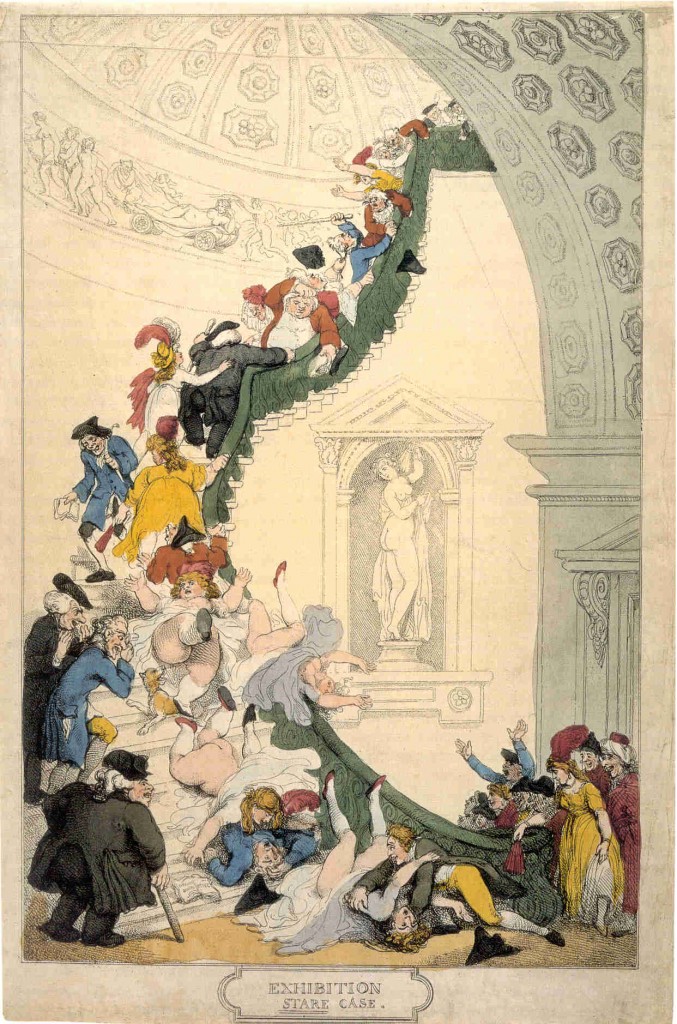
Read More: http://www.english.wisc.edu/tkelley/NASSR/ ---This work depicts the staircase leading to the Great Room at Somerset House. The later version, circulated as a print, replaces the urn at the bottom of the staircase in the original with a statue of the Callipygian Venus . Dian K. Kriz recounts a number of commentaries regarding the staircase that inspired Rowlandson's work, dating back to 1785, which occur in reviews of the exhibitions "that addressed the exhibition as a place where art and female bodies vied for the male gaze" . Two make particular reference to the original phenomena that Rowlandson spoofs in his caricature. The Morning Post, 3 May 1785, comments that "there are two descriptions of persons who visit the Royal Academyósome perambulate the rooms to view the headsóothers remain at the bottom of the stairs to contemplate the legs"; while the World, Fashionable Advertiser, 8 May 1787, notes that "Exhibitions are now the rageóand though some may have more merit, yet certainly none has so much attraction as that at Somerset House; for, besides the exhibition of pictures living and inanimate, there is the raree-show ...
By the middle of the eighteenth-century there were artists like Reynolds, Hogarth,Gainsborough and Richard Wilson who could compare with the best of their contemporaries on the Continent, which led ultimately to the formation of the Royal Academy of Arts. There was a public that would pay to see new pictures, enhanced by the gifts of Joshua Reynolds as both catalyst and manipulator. No man who was not himself remarkable could have been the close friend of Johnson, Burke, Goldsmith and Boswell.
Reynolds was forty-five when the R.A. came into being, and he remained its president until his death twenty-four years later. He, more than any other man, gave the institution its tone. That tone was not to everyone’s taste. It exasperated those who felt that it is no part of an artist’s business to treat the world of wealth and fashion on its own terms. To this day, we can see the corrupting influence of high society on artists who allow themselves to be annexed by it. To live like a pig and paint like Titian or to live like Titian and paint like a pig?
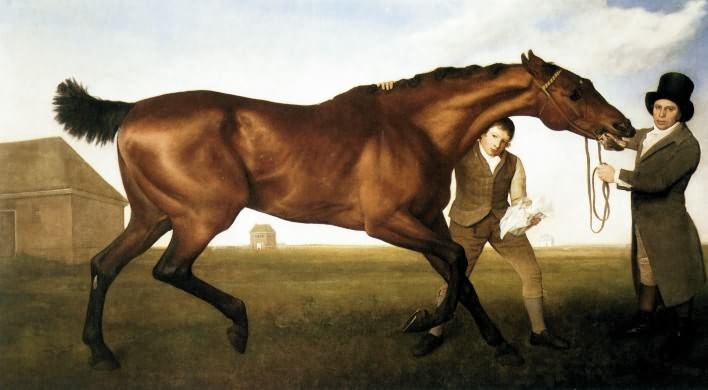
Read More:http://www.theliferoom.org/site/archives/452 Stubbs.---With Stubbs in particular there is a thoroughly new feeling in the paint for the morphology of the animal and for the relationship between figure and ground, and in Hambletonian, Rubbing Down the artist has bequeathed to successive generations one of the finest works ever painted by a British artist. This extraordinary composition has never lost its capacity to astonish, a capacity contrived from Stubbs’s ambitiousness of scale and the assuredness in his handling of the subject. Much of its power derives from the fact that the artist has compressed the horse and its two handlers into a box-like space, cramping them together on what are otherwise the wide-open spaces of Newmarket Heath. This has the effect of focusing the viewer’s attention on Hambletonian’s nervous eye and heaving flanks, evidence of a harrowing race of marathon proportions. Stubbs’s highly developed sensibility was founded on his incomparable familiarity with the anatomy of the thoroughbred and leaves us in no doubt that his observations led him to look upon the racehorse as a vessel of transcendence, the quality which is just as readily associated with the achievements of artists as it is with those of athletes.---
Not surprisingly, it was William Blake who put forth the extreme anti-Reynolds case. As a student of the R.A. schools in 1778 he had not been happy, and throughout his life he felt that, as he wrote in the margins of Reynold’s “Works” : This Man Was Hired to Depress Art. What was important in England, he wrote, ” is not whether a man has talents & genius, but whether he is PAssive and Polite & a Virtuous Ass & Obedient to Nobleman’s Opinions in Art & Science.” Observe the imposing nobodies in the market today, and remark on the business/patron/corporate to artist relation in action, and you will agree that corporate money values have subsumed art, and there is a great deal of truth in what Blake said.
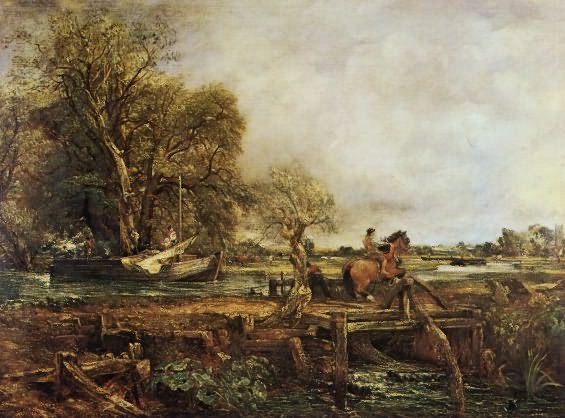
Read More:http://www.tate.org.uk/britain/exhibitions/constable/rooms/4-leapinghorse.htm John Constable.---The Leaping Horse is the sixth and last of the large River Stour scenes exhibited between 1819 and 1825. It shows a rider urging a barge horse to jump over a barrier on the towpath. It is set at a site called the Float Bridge, further towards Dedham upstream from Flatford. The painting is deliberately ‘grand’ in conception and recalls some of the great equestrian portraits of the past by Leonardo and Velazquez. It is less specific in its sense of a particular moment than Constable’s earlier Stour paintings: instead of being set at noon, for instance, it focuses on wind and light in a more abstract and generalised fashion. Constable uses the turbulent sky to echo the energetic movement of horse and rider.---
Reynolds, however, believed that the artist was not a gypsy or an itinerant comedian, to come begging at back doors for the chance of showing his skill, but a professional gentleman who should be able to treat with the great figures of this world as prince with prince. For this he needed security and an imposing establishment; but he also needed the kind of personal distinction which not many artists of that day could claim. Reynolds was just the man. For it was to Reynolds that the R.A. owed not only its high place in English society but the easy and expansive tone of its entertainments.
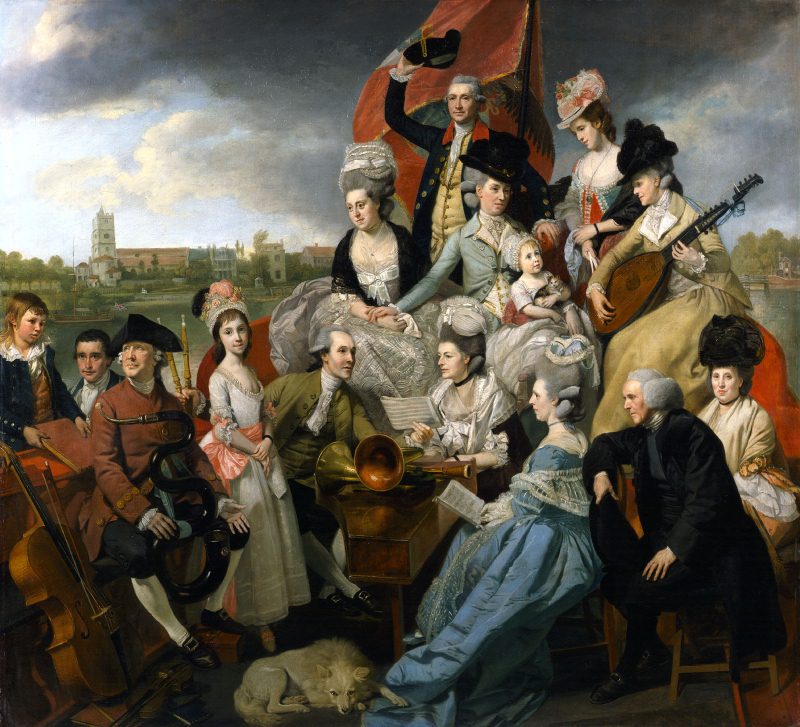
Read More:http://www.historytoday.com/blog/2012/02/slideshow-paintings-johan-zoffany---In March, the Royal Academy in London launches a major new exhibition on Johan Zoffany, one of the most influential artists of the 18th-century.---
ADDENDUM:
Donald Kuspit: ( see link at end) : I will suggest that the irrational exuberance of th
ntemporary art market is about the breeding of money, not the fertility of art, and that commercially precious works of art have become the organ grinder’s monkeys of money. They exist to increase the generative value and staying power of money — the power of money to breed money, to fertilize itself — not the value and staying power of art.
Money supposedly has no value in itself, that is, it is valuable for what one can exchange it for, but I will suggest the surge of art buying is money’s parthenogenetic way of saying that it is valuable in itself, indeed, value distilled to purity, the quintessence of value in capitalist society.
Many years ago Meyer Schapiro argued that there was a radical difference between art’s spiritual value and its commercial value. He warned against the nihilistic effect of collapsing their difference. I will argue that today, in the public mind, and perhaps in the unconscious of many artists, there is no difference. The commercial value of art has usurped its spiritual value, indeed, seems to determine it. Art’s esthetic, cognitive, emotional and moral value — its value for the dialectical varieties of critical consciousness — has been subsumed by the value of money.
Art has never been independent of money, but now it has become a dependency of money. Consciousness of money is all-pervasive. It informs art — virtually everything in capitalist society — the way Absolute Spirit once did, as Hegel thought. Money has always invested in art, as though admiring, even worshipping, what it respected as its superior — the true treasure of civilization — but today money’s hyper-investment in art, implicitly an attempt to overwhelm it, to force it to surrender its supposedly higher values, strongly suggests that money regards itself as superior to art….
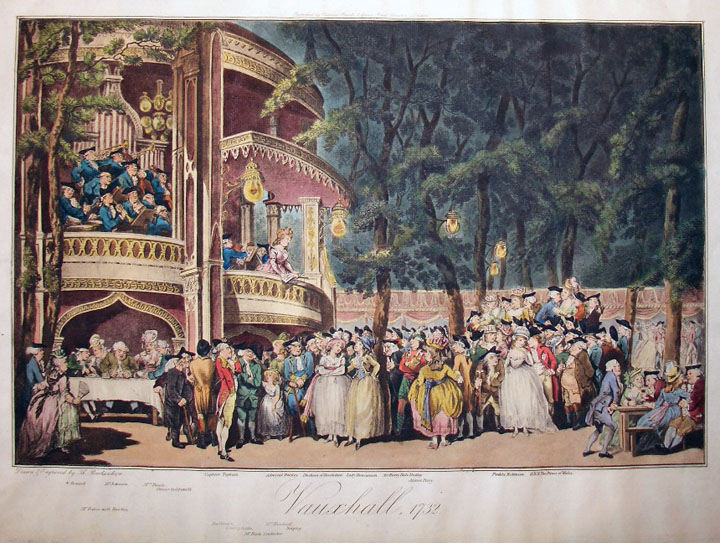
Read More:http://blogs.princeton.edu/graphicarts/2009/05/vauxhall_gardens.html ---In 1784, British artist Thomas Rowlandson submitted two watercolors to the Royal Academy member’s exhibition: The Serpentine River and Vauxhall. They were recognized by the critics and at 28 years-old, Rowlandson emerged as an artist of note. The later work was engraved by Robert Pollard for wide distribution the following year. One of the finest aquatintists of the period, Francis Jukes (1745-1812), was hired to recreate the look of the watercolor and the print was published by John Raphael Smith (1752-1812), one of the leading printmakers of the day, who published prints after Gainsborough, Reynolds, and Romney. In Vauxhall, figures are caricatured but identifiable, including Mrs. Weichsel singing from the front balcony and Mr. Barthelemon leading the orchestra. Below is a supper party with James Boswell, Dr. Samuel Johnson, Mrs. Thrale, and Oliver Goldsmith. Boswell did frequent Vauxhall and said “I am a great friend to pubic amusements; for they keep people from vice. You would now have been with a wench had you not been here.” Playwright and columnist Captain Topham is looking through a spyglass at the Duchess of Devonshire and her sister, Lady Duncannon. Further to the right, the Prince of Wales flirts with his former mistress Perdita Robinson, who remains on the arm of her husband.---
…Art’s willingness, even eagerness to be absorbed by money — to estheticize money, as it were — suggests that art, like every other enterprise, from the cultural to the technological (and culture has become an extension and even mode of technological practice in many quarters) is a way of making and worshipping money — a way of affirming capitalism. Read More:http://www.artnet.com/magazineus/features/kuspit/kuspit3-6-07.asp







 COMMENTS
COMMENTS



